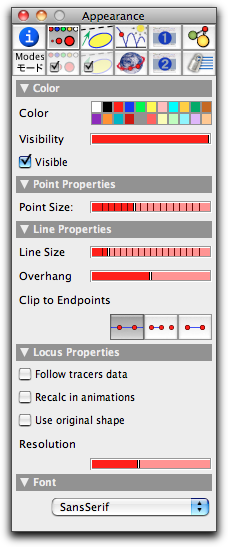LocusLocusConstructing Loci
The mover, road, and tracer must be selected in this order. However, if the mover is either a "point on a line," a "point on a circle," or a "line through a point," then Cinderella automatically recognizes that there is a unique road and selects it for you automatically. You should watch the message line to check what input is required at each stage of a construction. Currently, the following combinations of mover and road are supported:
Cinderella also supports the selection of a "line" as the tracer. In this case the envelope of the moving line is calculated.
Loci of elements are real branches of algebraic curves. Cinderella will always try to generate an entire branch. Inspecting LociCompared to Cinderella 1.4, loci have become much more flexible and powerful. Most of the new functionality is accessible through the inspector. Here we give only a rough overview of the possibilities. In the appearance tab of the inspector a selected locus offers the following control access:
Usually, loci are drawn as lines, so only the color, visibility, and line size controls will be relevant. However, in Cinderella.2 it is also possible to present a locus as sample snapshots of the trace element. In this way, the locus of a moving point is drawn as a sequence of points. Hence in this case, the appearance controls for points will also be relevant. The behavior of the locus can be influenced by the "Locus Properties" section of at the bottom of the inspector. The precise meanings of the three checkboxes are as follows:
The resolution slider allows for control of the number of sample points in a trace. To get a slight impression of the possibilities of the new locus features, consider the example given by the following construction:
The two pictures below show two different ways of presenting the locus.
The first picture shows the plain locus. After adding the line D.color=hue(B.angle/pi/2) in the CindyScript panel, the tracer changes its color in accordance with the angle of the mover. If one then checks the "Use original shape" box and the "Follow tracers data" box, the resulting image is the one on the right. Observe that in this way, one recognizes, the nontrivial way in which the tracer follows the figure eight in this example. SynopsisGenerate a geometric locus by selecting a mover, a road, and a tracer. CautionSometimes you will notice a short delay when a locus is being calculated. Do not blame your computer or Cinderella (or, even worse, the authors). These delays can be caused by extremely difficult calculations that are necessary to get the correct result (a complete branch of the curve) or the correct screen representation after a movement. We have tried our best to speed up these calculations, but there is a (mathematical) limit: We do not want to sacrifice accuracy for speed.
Contributors to this page: Richter
,
Kohler
,
Kortenkamp
and
Kramer
. The content on this page is licensed under the terms of the License. |
Login |





